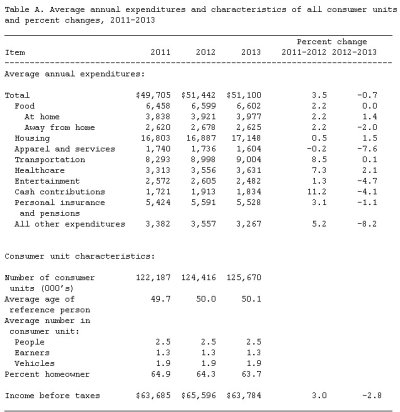One of the small items that slip under the radar... Nothing really new here, but some stuff you didn't see in the news:
Consumer Price Index (CPI)
The only thing that I don't like, is the presumed substitution calculation... already in effect, but IMHO not fair...
It's the idea that the new norm will be the measure of CPI... ie. if people don't buy steak because it's too expensive, the the new measurable norm could be hamburger.
The CPI affects me, in IBonds, and in the fees for my Florida community ownership. In the case of IBonds, lowering the food cost basis in the CPI, means that the interest rates are lower than what they would be without the "averaging". The chained CPI has the same effect.
Not a large amount, but, a few dollars here and a few dollars there and......
BTW... if you should go to the first link, there's also a second (recent) link that reviews changes in pension plans. If you're in that column, it may interest you.
Link:http://www.bls.gov/opub/btn/volume-4/a-look-at-todays-pension-equity-plans.htm
Consumer Price Index (CPI)
Announcements
New Estimation System
Effective with the release of the January 2015 CPI on February 26, 2015, the Bureau of Labor Statistics will utilize a new estimation system for the Consumer Price Index. The new estimation system, the first major improvement to the existing system in over 25 years, is a redesigned, state-of-the-art system with improved flexibility and review capabilities. For more information on this new system, please see How BLS Measures Changes in Consumer Prices.
Chained Consumer Price Index to be Revised Quarterly
Effective with the release of CPI data for January 2015 on February 26, 2015, the Bureau of Labor Statistics will begin quarterly revisions of the Chained Consumer Price Index for All Urban Consumers (C-CPI-U). In addition, a Constant Elasticity of Substitution (CES) formula will replace the geometric mean formula for the calculation of Initial and Interim C-CPI-U indexes. For additional information, please see How BLS Measures Changes in Consumer Prices.
The only thing that I don't like, is the presumed substitution calculation... already in effect, but IMHO not fair...
It's the idea that the new norm will be the measure of CPI... ie. if people don't buy steak because it's too expensive, the the new measurable norm could be hamburger.
The CPI affects me, in IBonds, and in the fees for my Florida community ownership. In the case of IBonds, lowering the food cost basis in the CPI, means that the interest rates are lower than what they would be without the "averaging". The chained CPI has the same effect.
Not a large amount, but, a few dollars here and a few dollars there and......
BTW... if you should go to the first link, there's also a second (recent) link that reviews changes in pension plans. If you're in that column, it may interest you.
Link:http://www.bls.gov/opub/btn/volume-4/a-look-at-todays-pension-equity-plans.htm
Last edited:

 I should stick to stuff I know... like afternoon naps.
I should stick to stuff I know... like afternoon naps.

